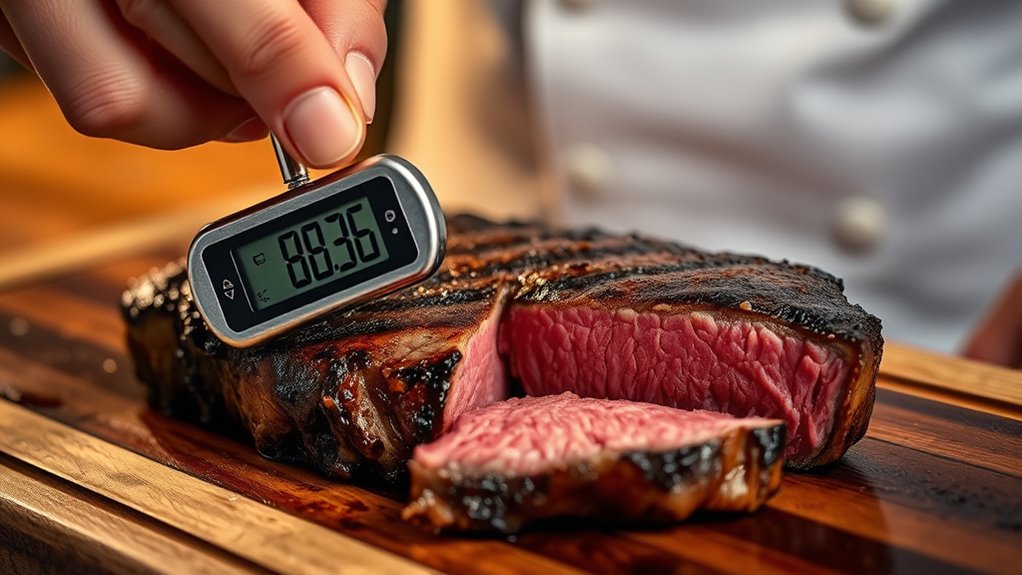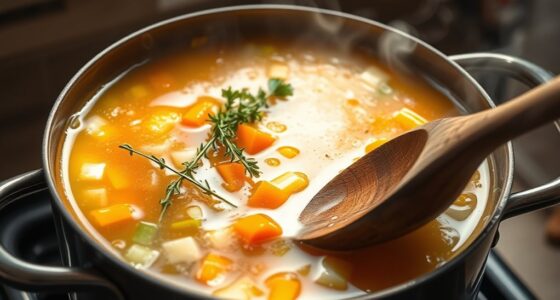To cook meat to the perfect temperature, you should use a reliable meat thermometer and insert it into the thickest part of the meat, avoiding bones and fat. Check the temperature frequently to guarantee it reaches the safe minimum (like 165°F for poultry or 145°F for steaks) and remove it just before it hits that mark to let residual heat finish the job. Rest the meat afterward to lock in juices and finish cooking safely; you’ll discover more tips on achieving perfect doneness as you continue.
Key Takeaways
- Insert the thermometer into the meat’s thickest part, avoiding bones and fat, for an accurate reading.
- Check the internal temperature periodically during cooking to ensure proper doneness.
- Use temperature charts to determine the safe minimum internal temperatures for different meats.
- Remove meat just before reaching the target temperature to account for residual heat during resting.
- Rest the meat for several minutes after cooking to allow juices to redistribute and temperature to stabilize.

Cooking meat to the right temperature is essential for ensuring it’s safe to eat and retains the desired texture and flavor. When you pay close attention to meat safety, you’re not just avoiding foodborne illnesses; you’re also making sure your meat reaches that perfect level of doneness. Using a reliable thermometer is the best way to achieve this. Relying solely on cooking times or visual cues can be unreliable because meat can vary in thickness, starting temperature, and cooking environment. With a thermometer, you get an accurate reading that helps you cook your meat perfectly every time.
To make sure you’re hitting the right temperature, it’s helpful to refer to temperature charts that detail safe minimum internal temperatures for different types of meat. These charts are designed based on food safety guidelines that specify what temperature kills harmful bacteria. For example, poultry should reach 165°F (74°C), ground meats like beef or pork should reach 160°F (71°C), and steaks or chops can be cooked to a range depending on your preference but should at least reach 145°F (63°C) with a rest time. These temperature charts serve as your trusted guide, helping you avoid undercooking or overcooking your meat.
When you insert your thermometer, do so into the thickest part of the meat, avoiding bones or fat, which can give inaccurate readings. Make sure the thermometer’s tip is fully submerged in the meat’s center for the most precise result. As you cook, check the temperature periodically; don’t rely solely on the timer. Remember, residual heat can continue to cook the meat even after you remove it from the heat source, so it’s wise to take it out when it’s just a few degrees below your target temperature. Resting the meat allows juices to redistribute and the temperature to stabilize, ensuring your meat is both safe and tender. Additionally, regular appliance maintenance plans can help ensure your cooking appliances function correctly, providing consistent heat for accurate cooking.
Using a thermometer and referring to accurate temperature charts isn’t just about safety; it’s about achieving the perfect texture and flavor. You’ll notice the difference in your dishes when you cook meat to the recommended internal temperature. It guarantees the meat is cooked just right—juicy and tender without any risk of harmful bacteria. Over time, you’ll develop a sense for when your meat is done, but always rely on your thermometer to confirm. It’s a simple tool that can elevate your cooking from good to great, giving you confidence that every piece you serve is both safe and delicious.
Frequently Asked Questions
How Do I Calibrate My Meat Thermometer Accurately?
To calibrate your meat thermometer accurately, start with calibration methods like ice water and boiling water tests. For ice water, submerge the probe in a mixture of ice and water, ensuring it’s not touching the sides or bottom, and check if it reads 32°F (0°C); modify if needed. For boiling water, ensure it reads 212°F (100°C) at sea level. Regular calibration maintains your thermometer’s accuracy, helping you cook meat perfectly every time.
What Is the Safest Way to Store Cooked Meat?
Ever wonder how to keep cooked meat safe? You should store it promptly in airtight containers or wrap it tightly in foil to prevent contamination. Keep it in the refrigerator at 40°F (4°C) or below, and consume within 3-4 days to prevent spoilage. For longer storage, freeze it. Proper food storage is key to spoilage prevention and maintaining quality. Always reheat thoroughly before eating leftovers.
Can I Use a Meat Thermometer for Poultry and Fish?
Yes, you can use a meat thermometer for poultry and fish. It’s essential for ensuring poultry safety, as you need to reach an internal temperature of 165°F, and for fish, following fish temperature guidelines of 145°F helps prevent foodborne illnesses. Using a thermometer provides accurate readings, so you cook these proteins thoroughly without overcooking. Just make sure the thermometer is suitable for different meats and easy to sanitize.
How Long Should I Rest Meat After Reaching Target Temperature?
You should rest your meat for about 5 to 15 minutes after reaching the target temperature, depending on its size. Resting allows the temperature carryover, where heat continues to distribute evenly, ensuring juiciness and perfect doneness. During this resting time, the internal temperature may rise slightly, so it’s crucial to account for this to avoid overcooking. Cover loosely with foil to retain heat without steaming.
Are Digital Thermometers More Reliable Than Analog Ones?
Digital thermometers are generally more reliable than analog ones because their digital accuracy provides precise readings quickly, helping you cook meat perfectly. While analog thermometers are known for their durability, they can be less precise and harder to read, especially in low light. If accuracy matters most to you, opt for a digital thermometer, as it offers consistent results and is easier to use, ensuring your meat reaches the perfect doneness every time.
Conclusion
Using a thermometer takes the guesswork out of cooking meat, ensuring every bite is just right. With accurate temperatures, you’ll enjoy perfectly cooked dishes every time, reducing the risk of under- or overcooking. So, why settle for less when you can achieve professional results at home? Invest in a good thermometer, follow the guidelines, and savor the delicious confidence that comes with perfectly cooked meat—because your taste buds deserve it.








